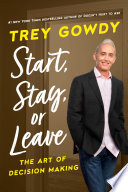

The first step in the decision-making process is to thoroughly assess your current situation. This involves introspection and an honest evaluation of your feelings, motivations, and circumstances. By identifying what you truly want and what you are currently experiencing, you can create a clearer picture of whether to start something new, stay where you are, or leave for better opportunities. This requires looking at both the emotional and practical aspects of your situation, including job satisfaction, personal fulfillment, and external factors such as market conditions or life changes.
Continue readingOnce you understand your current situation, the next step is to evaluate potential opportunities. This involves researching and analyzing different paths you could take, whether it's a new job, a side project, or even pursuing further education. The evaluation should consider factors such as growth potential, alignment with personal values, and the likelihood of success. It’s essential to weigh the pros and cons of each opportunity, considering both short-term and long-term implications. This analysis will help clarify whether a new venture is worth pursuing.
Continue readingTiming can be a crucial factor in deciding whether to start, stay, or leave. The book emphasizes that the right moment can significantly impact the success of your decision. It discusses how personal circumstances, market trends, and even economic conditions can influence the timing of your choices. Understanding when to make a move is as important as understanding what move to make. This section encourages readers to be aware of external signals and to trust their instincts when it comes to timing their decisions.
Continue readingTo make informed decisions, the book advocates for establishing a decision-making framework. This framework involves setting criteria that are important to you, such as financial stability, work-life balance, and career advancement. By having a structured approach, you can better evaluate your options against these criteria. This framework helps to minimize emotional biases and provides a clearer pathway to making rational choices. The book provides practical tools and methods for creating this framework, making it actionable for readers.
Continue readingFear and uncertainty are common emotions that can hinder decision-making. The book addresses these feelings head-on, providing strategies to manage and overcome them. It encourages readers to confront their fears by breaking down the decision into smaller, manageable parts and addressing each concern individually. By doing so, individuals can gain confidence and clarity, making it easier to move forward with their decisions. This section also highlights the importance of support systems, whether through mentorship, peer groups, or professional networks.
Continue readingThe final step in the process is taking action based on your decisions. The book emphasizes that the best decision is rendered ineffective without implementation. It discusses strategies for transitioning into new roles, starting new projects, or making significant life changes. This includes setting realistic goals, creating action plans, and maintaining accountability. The author stresses the importance of perseverance and adaptability, as the initial plan may need adjustments along the way. Taking action is portrayed not just as a step but as an ongoing process of learning and evolving.
Continue readingAfter taking action, it is essential to reflect on the outcomes of your decisions. The book encourages readers to engage in continuous learning by evaluating what worked, what didn’t, and why. This reflection process is crucial for personal and professional growth. By analyzing past decisions, individuals can refine their decision-making framework and improve future choices. The book promotes a mindset of lifelong learning, where each experience serves as a building block for future endeavors.
Continue reading